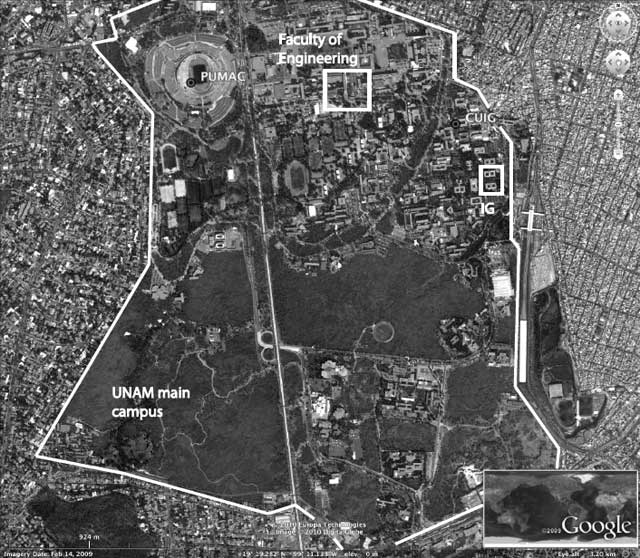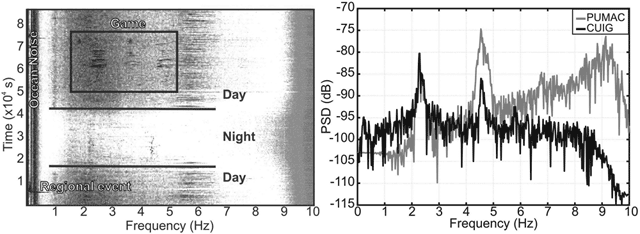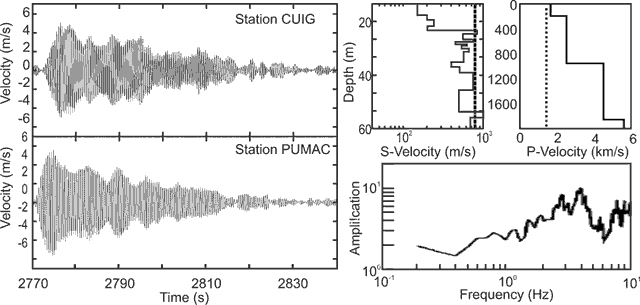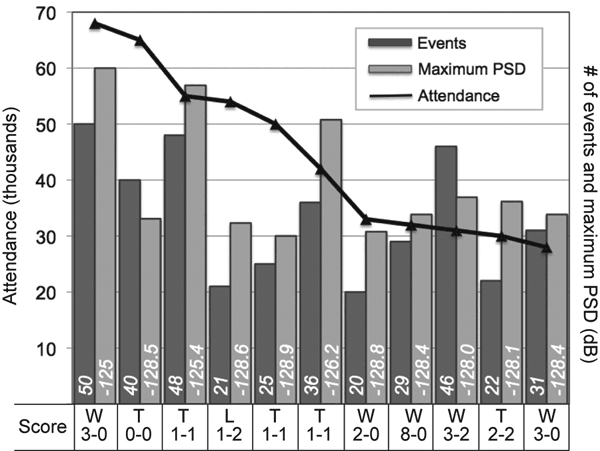| Publications: SRL: EduQuakes |

EduQuakes
January/February 2011
How a Soccer Stadium Helps with an Education in Science and Seismology
Diego Melgar and Xyoli Pérez-Campos
 Click to Show (or Hide) Authors' Affiliations
Click to Show (or Hide) Authors' Affiliations
- Facultad de Ingeniería, Universidad Nacional Autónoma de México, México, D.F., México; now at Cecil H. and Ida M. Green Institute of Geophysics and Planetary Physics, Scripps Institution of Oceanography, La Jolla, California, U.S.A.
- Departamento de Sismología, Instituto de Geofísica, Universidad Nacional Autónoma de México, México, D. F., Mexico.
INTRODUCTION
At Universidad Nacional Autónoma de México (UNAM) there is a tight bond between researchers from the Geophysics Institute’s (IG) Seismology Department and geophysics engineering undergraduate students from the university’s Faculty of Engineering. Several researchers teach a number of math, physics, geophysics, and seismology-related courses and are often on the lookout for undergraduate students whom they can recruit for their research activities. Conversely, a student might reach out to the researcher and indicate an interest in extending his or her activities beyond the classroom.
Senior students who are more versed in the disciplines of geophysics often know which field they would like to extend their activities into and are more readily absorbed into some research group. However, if the student is still at an early stage in his or her degree, finding suitable activities for him or her is more challenging because of the student’s limited knowledge of the underlying physics and underdeveloped mathematical toolkit.
Here we will discuss the experiences gained from such a case in which, under an adviser’s guidance, a student undertook a very simple yet enlightening research project in seismology at the middle of his degree in geophysics engineering. We will show how the project aided the student in preparing and developing basic scientific research methodologies, critical analysis capabilities, and essential seismological tools for a more serious investigation in seismology and tectonophysics that was to happen later as part of his undergraduate thesis.
THE PROJECT
With the intent of designing a research experience that was fun and engaging, yet scientifically sound, an old project that was almost a rumor was resurrected. The National Seismological Service (SSN), operated for the Mexican government by the IG, has a broadband network throughout the country. One of the stations, CUIG, is located in a vault within UNAM’s main campus in southern Mexico City. A basaltic masonry stadium, built to host the 1968 Olympics with a seating capacity of 63,000, is located 1.5 km away from the seismometer (Figure 1). The Olympic glory is all but faded now, but the stadium still hosts one of the most popular teams in the Mexican professional soccer league, the UNAM Pumas.
The story goes that on a night in August 2003, an intern serving on the graveyard shift at the SSN saw her routine activities interrupted by an alarm indicating seismic activity was being registered at station CUIG; however, when she looked at the records, she could not discern any earthquakes but could observe some signal with waveforms very different from the tell-tale shapes of earthquakes.
After a few more alarms, and recalling that it was a game day, she correlated this activity to a very noisy game happening at the stadium, concluding that the stadium must be the source of this noise. Whether the stadium’s signal actually tripped the alarm is the subject of folklore, but the project set forth to our student was to investigate whether any signal was registered at CUIG during Pumas games and to characterize said signal, and perhaps answer basic and fun questions such as: Could you read the story of the game from the record? Can you pinpoint where the goals happen? Can you tell where a close call happened and if a shot hit the crossbar?

▲ Figure 1. Aerial view of the UNAM campus in southern Mexico City. Station PUMAC was deployed for a game at field level. Station CUIG is a permanent broadband station operated by the National Seismological Service. Click image to view at larger size.
The Essential Tools
When the project began, the first step was for the student to become acquainted with the basic computing framework that is used by most seismologists at one point or another: how to utilize a command line OS (Sun Solaris in this case) and query via ftp the database, utilizing SAC to correct the records for instrument response (after a brief detour to explain basic linear systems theory and why instrument correction is necessary); and how to utilize shell scripts to take the tedium out of processing records for multiple games.
After these data collection preliminaries, the advisor decided that Matlab was the most suitable platform for the student to develop his own software, both because of some previous knowledge he had of the scripting language and because of routines already built in, which given his limited knowledge of many analysis tools enabled him to utilize pre-coded functions.
Analyzing the Records
By suggestion of the adviser and given that the student was already taking his first Fourier theory course, the first step was to elaborate spectrograms of some of these signals. Given that the student was still unaware of the intricacies of spectral estimation but was conscious of the information that could be obtained from analyzing signals in the frequency domain, Matlab’s built-in spectrogram function was adequate. After some exploration into its different parameters, the student finally devised the optimum form of elaborating the spectrograms and proceeded to look at 24 hours of broadband velocity records for thirty days in which there had been games.
Straightaway one could observe that there was a suite of signals on the records that needed explanation. Figure 2 shows a characteristic spectrogram where one can clearly distinguish between day and night, observe the pervasive low frequency peak due to ocean waves, and see a clear set of signals during game time distributed over three frequency bands, 2.2 Hz, 3.5 Hz, and 4.7 Hz. Also, in some spectrograms, one can notice signals due to small regional events. The spectral peaks were observed for all 30 spectrograms, with varying power but almost constant frequency throughout.

▲ Figure 2. Frequency domain analysis. Left: A typical spectrogram with several observed features: a game at the stadium, ocean noise, day and night and a small regional event. Right: PSD computed for the duration of a game for stations PUMAC and CUIG. Click image to view at larger size.
A few months before this project began and as an excuse to attend a sold-out game, a few researchers from the IG deployed a Guralp CMG-3T sensor on the field during a game (station PUMAC, see Figure 1). Once the spectrogram analysis was complete for CUIG, the analysis was shifted to comparing signals recorded inside the stadium at station PUMAC and signals recorded for the same game 1.5 km away at CUIG. Still working in the frequency domain, the student obtained the power spectral density (PSD) for the duration of the game for stations PUMAC and CUIG. When plotted together some interesting features are evident (Figure 2). Other than the aforementioned spectral peaks, it is interesting to note that the power of the 2.2 and 3.5 Hz peaks seem unaffected by the trajectory between CUIG and PUMAC, while the 4.7 Hz peak’s power diminishes by some 10 dB, thus illustrating the notion of both attenuation and the Earth as a frequency selective filter.
After this, analysis shifted to the time domain. Because of the apparent stability of this frequency band, the student narrowly bandpass-filtered the signal at 2.2 Hz with a fourthorder Butterworth filter, again, after detouring into some essentials of filtering such as zero phase filtering. The resulting signal shows noise, except for short bursts of activity during game time. The student identified the origin time of one of these bursts at station PUMAC (inside the stadium) and then visually correlated and flagged that same event at station CUIG 1.5 km away (Figure 3). He then computed the crosscorrelation between both signals and found that the maximum correlation occurred with a lag of 2.05 s, which given the fact that cultural noise consists of Rayleigh waves (Bard 1998) and that shear wave velocity can be loosely related to phase velocity by cx = 0.92 ( = S-wave velocity), yields an average S-wave velocity of 732 m/s and a P-wave velocity (assuming a Poisson solid) of 1,267 m/s for the structure between the stadium and the station CUIG’s vault.

▲ Figure 3. Time domain analysis. Left: the signal has been narrowly bandpass-filtered around 2.2 Hz. We observe an event on the vertical component of stations CUIG and PUMAC; the maximum value of the cross-correlation between both waveforms has been used to determine a lag of 2.05 s between the two. Right: Comparisons with the S-wave velocity and attenuation models of Singh et al. (1995) and with the P-wave velocity model of Flores Estrella (2004). The velocities computed by cross-correlation are indicated by the dashed lines. Click image to view at larger size.
The student performed another analysis in the time domain was to determine if the number of events occurring in the 2.2 Hz band was somehow correlated with the outcome of the game. Instead of visually counting these events for all games, the student elaborated a simple short-term average/ long-term average (STA/LTA) algorithm, typically used in strong-motion sensors to trigger recordings, to count events, where each trigger counted as one event. The parameters of the STA/LTA algorithm were determined by trial and error for each game. Figure 4 shows the number of detected events and compares them to the maximum value of the power spectral density (PSD) and the scores and attendance of the games. It can be seen that high attendance does not increase the number of detected events, but high scoring or exciting games do— such as games with the traditional Pumas rivals.
Validating the Results
After all this was done, with some guidance by the adviser, the student was encouraged to verify, if possible, his results by comparing them to what other researchers had done. It was found that Singh et al. (1995) had shown that for station CUIG, attenuation at 2.2 and 3.5 Hz is almost null and that at 4.7 Hz there is some observable attenuation, verifying the conclusions from the comparison between stations CUIG and PUMAC. Additionally, in that same paper, Singh et al. (1995) elaborated a velocity model for the top 70 m around CUIG and found that shear wave velocity is 200 m/s for the top 15 m and increases to 700 m/s, on average, for the interval 20 to 70 m (Figure 3). Flores Estrella (2004) elaborated a deeper P-wave velocity model for the vicinity of station CUIG and showed a shear wave velocity of 1,500 m/s for the top 200 m (Figure 3). Given the gross way in which shear wave speed was determined by the student, it was concluded that both these studies demonstrated that the obtained results were plausible.

▲ Figure 4. Analysis of activity during Pumas games: dark gray bars indicate events detected in the 2.2 Hz frequency band by the STA/LTA algorithm and light gray bars indicate the maximum values of the PSD during the games. The numbers in the bars indicate the values. The dark line charts attendance. Below the bars are the scores for each game indicating if the outcome was a win (W), a tie (T), or a loss (L) for the home team. Click image to view at larger size.
CONCLUSIONS
This proved to be a very well-rounded project, from developing the aforementioned computing skills to a good amount of signal processing: preparing (detrending, tapering, etc.) signals for the elaboration of PSDs and spectrograms, deconvolution of the instrument response, cross-correlations, filtering, etc. It was also a chance to discuss basic seismological phenomena, body waves vs. surface waves, structure velocity models, attenuation, etc. But it also afforded the opportunity to exercise the muscle of scientific inquiry, that is, how to ask questions and how to go about answering them, scouring the literature for sources and asking has anyone done anything like this before and how do their results compare to what has been observed. All these basic notions, paramount for scientific work, can only be fully understood through practice. The student also prepared an oral presentation of his work for a national meeting (Melgar-Moctezuma et al. 2007) as well as a report that was published in the IG’s outreach publication sent to local high schools (Melgar-Moctezuma et al. 2008), further preparing him for both technical scientific communication and educating the public about science.
Elaborating projects to interest young students and introduce them into seismology and scientific research can be a challenging endeavor, one that requires creativity by scientists in advisory roles. It is important to make science fun for students without sacrificing rigor. Many ideas were left behind in this process: a six-station deployment was carried out for a game but the data were never analyzed as the student moved on to another project for his undergraduate thesis, leaving many questions unanswered. Sources of the signals at 2.2 and 3.5 Hz were never explained, nor was a mysterious very sharp peak at 1 Hz observed in many spectrograms. These issues lie in wait for the next adventurous undergraduate.
ACKNOWLEDGMENTS
We would like to thank Arturo Iglesias, whom we constantly distracted from his everyday seismological endeavors and who helped us cultivate the budding field of soccer seismology, as well as all the students who labor indefatigably on the SSN's night shift and who first identified this mysterious phenomenon.
REFERENCES
Bard, P. (1998). Microtremor measurements: A tool for site effect estimation? Proceeding of the Second International Symposium on the Effects of Surface Geology on Seismic Motion, Yokohama, Japan. 3, 1,251–1,279. Yokohama, Japan: IASPEI/IAEE.
Flores Estrella, H. (2004). Método SPAC: Una alternativa para la estimación de modelos de velocidades en el Valle de México. Master’s thesis, Posgrado en Ciencias de la Tierra, Instituto de Geofísica, UNAM, 236 pp.
Melgar-Moctezuma, D., X. Pérez Campos, and A. Iglesias (2007). Pumagrama: El registro sísmico de los Pumas de la UNAM. GEOS, Unión Geofísica Mexicana 2 (1), 114.
Melgar-Moctezuma, D., X. Pérez-Campos, and A. Iglesias (2008). Pumagrama: El registro sísmico de los Pumas de la UNAM. Geofisicosas 36, Available at http://www.geofisica.unam.mx/divulgacion/publicaciones/geofisicosas/geofisicosas36.pdf.
Singh, S. K., R. Quaas, M. Ordaz, F. Mooser, D. Almora, M. Torres, and R. Vasquez (1995). Is there truly a “hard” rock site in the Valley of Mexico? Geophysical Research Letters 22 (4), 481–484.
[Back]
| HOME |
Posted: 31 December 2010
